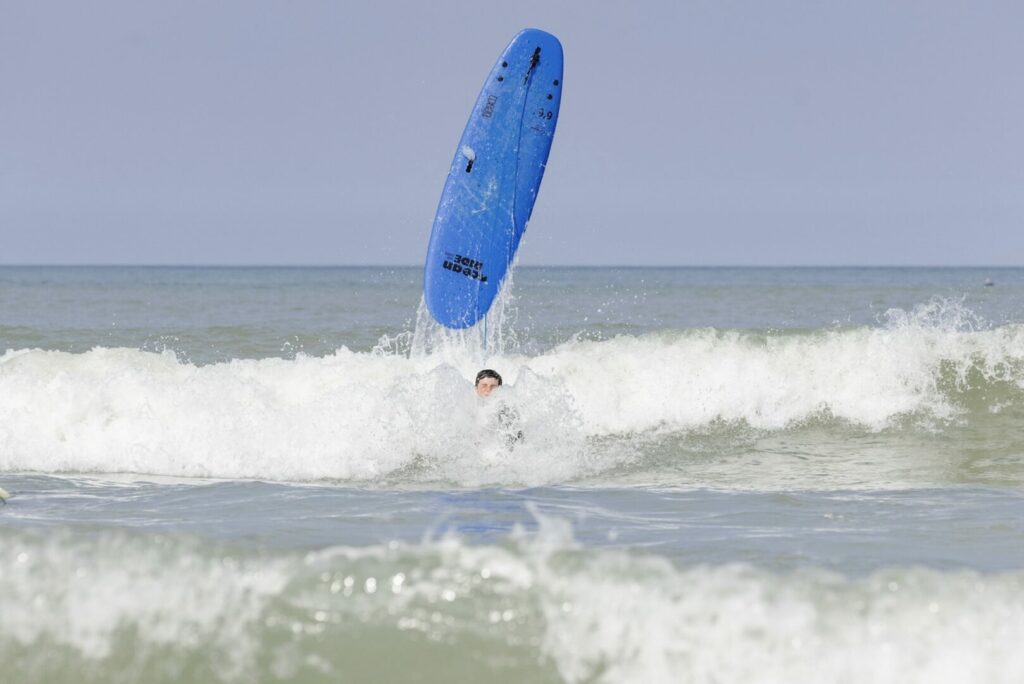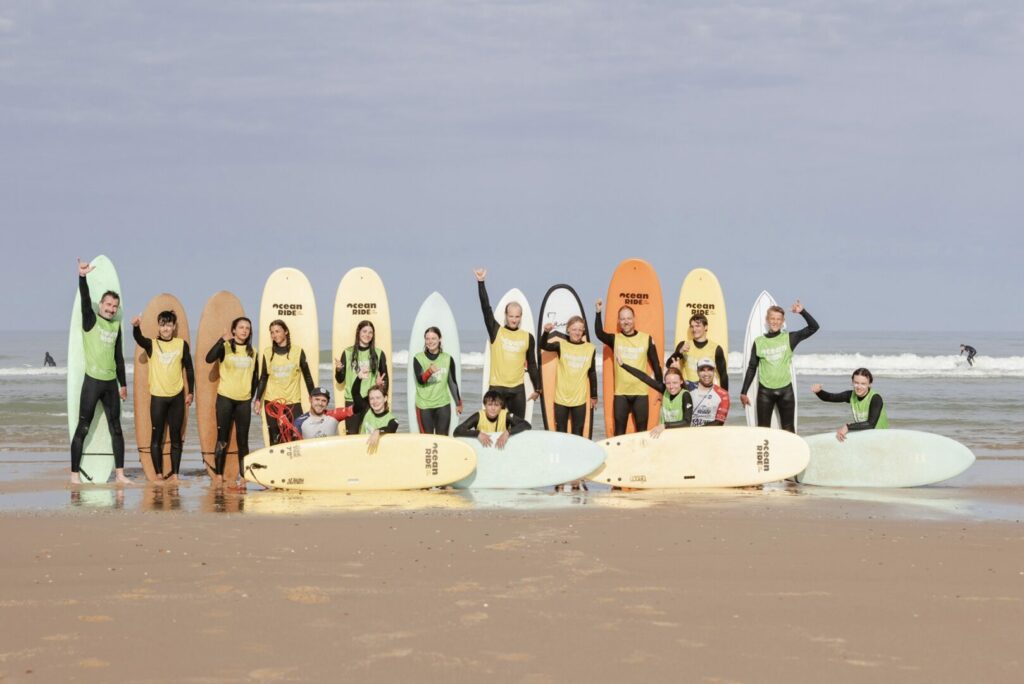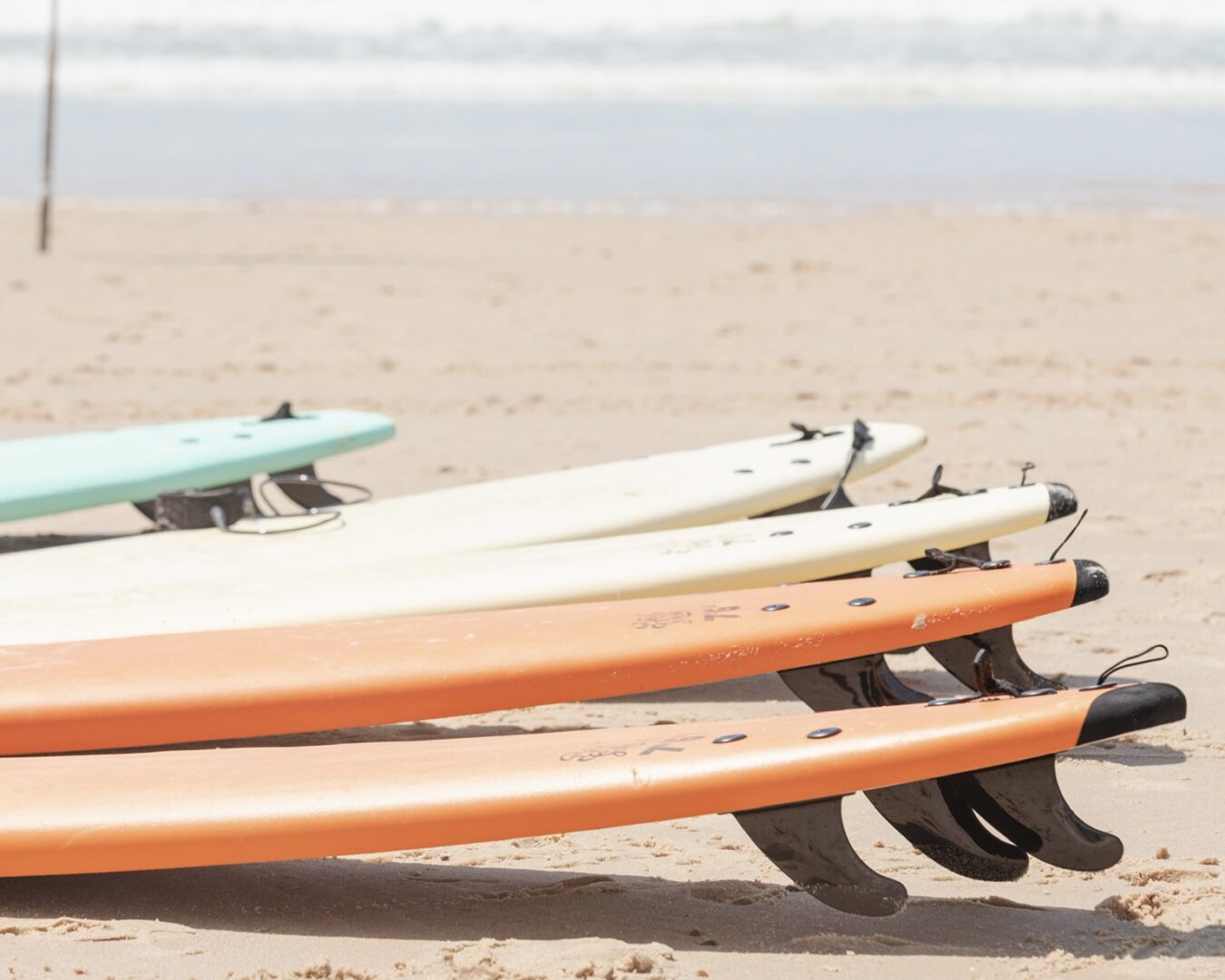How to Choose Your First Surfboard Without Getting It Wrong
Surfing isn’t something you improvise—and choosing your first surfboard even less so. Every beginner surfer has specific needs: stability, buoyancy, safety. Yet, many are tempted by overly “technical” models, thinking they’ll progress faster… The result? Slower progress, diminished confidence, and less enjoyment. We’re here to share our method to help you start off on the right foot. Whether you’re considering taking a lesson, renting, or buying, you’ll know exactly which board to choose to maximize your chances of success and enjoyment.
Starting Surfing Right Begins with the Right Board
Want to learn to surf under the best conditions? Start by choosing the board that suits you, the one that will help you build solid foundations. Too many beginners start with ill-suited equipment: boards that are too small, narrow, or too technical. This leads to frustrating sessions, slow progress, and sometimes even giving up.
A well-chosen board is your best ally to:
- Maintain balance from your first waves
- Avoid fatigue from inefficient paddling
- Build confidence with each session
Remember: “It’s not the board that makes the surfer… but it can either discourage or reveal them.”
The 5 Essential Criteria for Choosing Well
Choosing your first surfboard is fundamental. To maximize your chances of success from your first sessions in Lacanau (or elsewhere), you need to consider these 5 criteria. They will guide you towards an informed choice, suited to your beginner surfer profile, and above all, save you a lot of trouble.
1. Assess Your True Level
There’s no shame in being a beginner. The problem lies in believing you have a higher level than you actually do. Many new surfers want to skip steps. They end up with a board that’s too small, too thin, or simply too difficult to handle. And that’s often where things get complicated.
As a novice, you should look for a stable and forgiving board that will help you learn the right moves. That means: maximum volume, good width, and sufficient length for effective paddling. If you’ve already taken a few surf lessons, a slightly shorter board can be considered, provided it remains forgiving. But in any case, avoid pro boards, no matter how attractive they may look. They’re not your ally for starting out.
2. Match the Board to Your Body Type
Your weight and height directly influence the buoyancy and stability of your board. The heavier you are, the more volume the board needs to support you properly. Conversely, a lighter person won’t need as many liters. A voluminous board allows for better flotation, easier take-offs, and avoids sinking into the foam. It’s a guarantee for progressing under good conditions, without struggling with your equipment on every wave.

Recommended Board Types for Beginners
If you’re starting from scratch, the foam board is your best friend. With its soft foam covering, it prevents injuries, even when you fall headfirst. But above all, it’s an ultra-stable and super buoyant board. You paddle more easily, stand up faster, and spend less time underwater. It can be wide, long, stable, and therefore reassuring. It allows you to make mistakes, and that’s exactly what you need to progress with confidence. For an adult, aim for between 7’6″ and 8’0″.
Foam Board (Softboard)
If you’re starting from scratch, the foam board is your best friend. With its soft foam covering, it prevents injuries, even when you fall headfirst. But above all, it’s an ultra-stable and super buoyant board. You paddle more easily, stand up faster, and spend less time underwater.
It can be wide, long, stable, and therefore reassuring. It allows you to make mistakes, and that’s exactly what you need to progress with confidence. For an adult, aim for between 7’6″ and 8’0″.
Mini-Malibu
Have you already taken a few surf lessons? Do you feel that the foam board is becoming too easy for you? The mini-malibu is here to take you to the next level. It retains length and volume, so it remains stable, but its more refined shape makes it more maneuverable.
With it, you start to play with the wave: smoother curves, more dynamic sensations. But be careful, it’s not as forgiving as the foam board. It requires a bit more precision in paddling and positioning.
It’s the perfect board if you’ve already acquired the basics and aim to progress without skipping steps.
Longboard
The longboard is the ultimate chill board. Big, wide, ultra buoyant, it allows you to catch waves early and paddle effortlessly. It offers a long and smooth glide, perfect for soft waves like those in Lacanau, or small summer waves.
But it’s not the most maneuverable board. It can be a bit difficult to handle in hollow waves or when there’s a crowd. Best reserved for seasoned beginners, or as a second board after a foam board.
When you choose to take family surfing lessons in Lacanau, you’re opting for much more than just a simple activity. You’re treating yourself to an adventure rich in emotions and moments of complicity. By following our practical advice and letting yourself be guided by the magic of the waves, you’ll create unforgettable memories with your loved ones. So don’t wait any longer, book your stay and get ready to experience magical moments on the waves of Lacanau.
How to Choose Between These 3 Types?
Ask yourself this simple question: what do I want to feel when I surf?
- SIf you want to learn the basics safely → foam board
- If you have some experience and want to evolve → mini-malibu
- If you’re looking for smooth gliding, without rush or maneuvers → longboard
At Ocean Ride, we help you test several models according to your level. And above all, we guide you to never skip steps.

What to Absolutely Avoid
When starting out in surfing, there are mistakes we see every day in Lacanau. And believe us, they can cost you dearly: hindered progress, plummeting motivation, even total abandonment. That’s not what we want for you!
Here’s what to absolutely avoid when choosing your first surfboard:
- Choosing a board that’s too short
- Buying without trying. Every surfer is different; a board may be suitable for a friend… and not at all for you.
- Buying second-hand without checking the condition. A poorly repaired crack can turn a good board into a constant hassle.
- Thinking “it’ll get better later.” No, if your board isn’t suitable, you’ll repeat bad experiences. And it doesn’t get better over time.
Trust yourself, yes. But above all, trust us. We’ve seen hundreds of beginners before you.
Should You Buy or Rent Your First Board?
This is THE question all beginners ask themselves. And the answer mainly depends… on your commitment.
| Option | Advantages | Disadvantages |
|---|---|---|
| Renting |
– Test several types of boards – Progress without risk – Economical in the short term |
– Recurring cost if frequent sessions – Less personalization |
| Buying |
– You have your own equipment – You can surf whenever you want |
– Risk of a poor choice – High cost if the board is unsuitable – Board not suitable for all conditions |
Our advice is to rent 2 or 3 times with professional advice. We offer surf equipment rental throughout the season. Then, if you feel that surfing is becoming a passion, buy with the help of your instructor or a local shaper. You’ll make an informed choice, without regrets.
To sum up: a board that’s too small, too technical, or unsuitable for your level can hinder your progress, even discourage you from surfing. Conversely, a well-chosen board brings pleasure, confidence, and progress from the first waves.
The best of the best is to book a few lessons at our surf school in Lacanau so that our instructors can advise you best according to your level.

